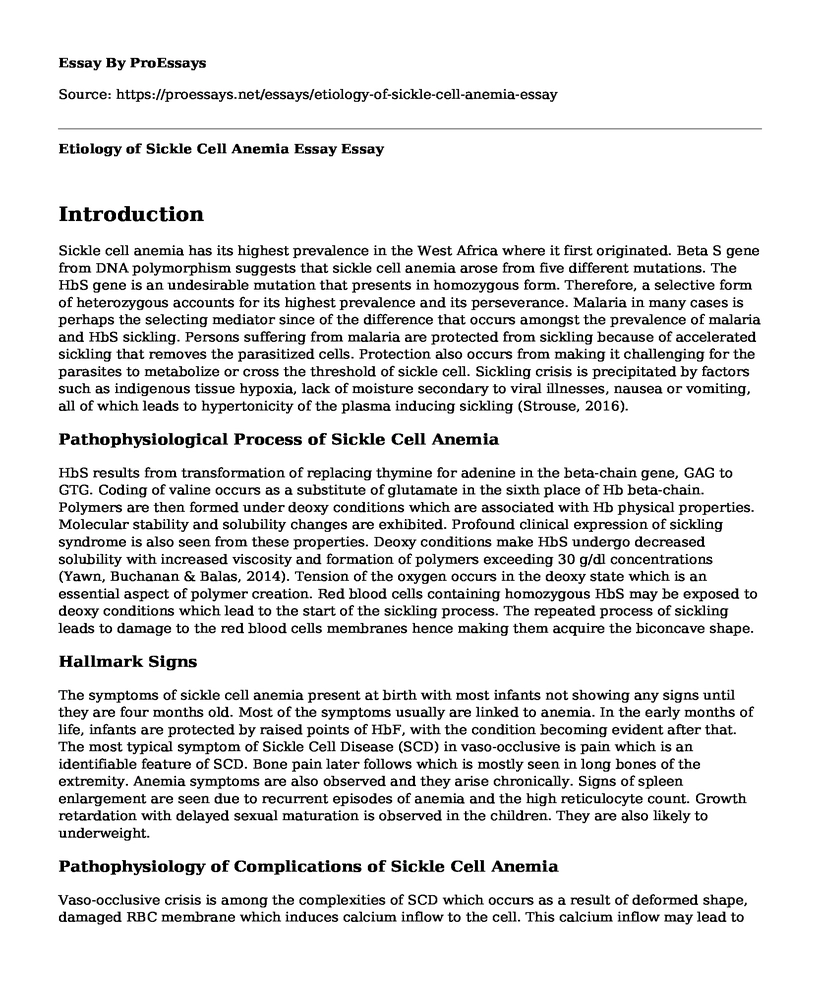Introduction
Sickle cell anemia has its highest prevalence in the West Africa where it first originated. Beta S gene from DNA polymorphism suggests that sickle cell anemia arose from five different mutations. The HbS gene is an undesirable mutation that presents in homozygous form. Therefore, a selective form of heterozygous accounts for its highest prevalence and its perseverance. Malaria in many cases is perhaps the selecting mediator since of the difference that occurs amongst the prevalence of malaria and HbS sickling. Persons suffering from malaria are protected from sickling because of accelerated sickling that removes the parasitized cells. Protection also occurs from making it challenging for the parasites to metabolize or cross the threshold of sickle cell. Sickling crisis is precipitated by factors such as indigenous tissue hypoxia, lack of moisture secondary to viral illnesses, nausea or vomiting, all of which leads to hypertonicity of the plasma inducing sickling (Strouse, 2016).
Pathophysiological Process of Sickle Cell Anemia
HbS results from transformation of replacing thymine for adenine in the beta-chain gene, GAG to GTG. Coding of valine occurs as a substitute of glutamate in the sixth place of Hb beta-chain. Polymers are then formed under deoxy conditions which are associated with Hb physical properties. Molecular stability and solubility changes are exhibited. Profound clinical expression of sickling syndrome is also seen from these properties. Deoxy conditions make HbS undergo decreased solubility with increased viscosity and formation of polymers exceeding 30 g/dl concentrations (Yawn, Buchanan & Balas, 2014). Tension of the oxygen occurs in the deoxy state which is an essential aspect of polymer creation. Red blood cells containing homozygous HbS may be exposed to deoxy conditions which lead to the start of the sickling process. The repeated process of sickling leads to damage to the red blood cells membranes hence making them acquire the biconcave shape.
Hallmark Signs
The symptoms of sickle cell anemia present at birth with most infants not showing any signs until they are four months old. Most of the symptoms usually are linked to anemia. In the early months of life, infants are protected by raised points of HbF, with the condition becoming evident after that. The most typical symptom of Sickle Cell Disease (SCD) in vaso-occlusive is pain which is an identifiable feature of SCD. Bone pain later follows which is mostly seen in long bones of the extremity. Anemia symptoms are also observed and they arise chronically. Signs of spleen enlargement are seen due to recurrent episodes of anemia and the high reticulocyte count. Growth retardation with delayed sexual maturation is observed in the children. They are also likely to underweight.
Pathophysiology of Complications of Sickle Cell Anemia
Vaso-occlusive crisis is among the complexities of SCD which occurs as a result of deformed shape, damaged RBC membrane which induces calcium inflow to the cell. This calcium inflow may lead to crosslinking of the tissue proteins thereby triggering the channels that allow outflow of potassium and water from the cell. The red blood cells gets dehydrated aggravating the sickling process. This catastrophe occurs as a result of sickle red cells that are obstructed which decreases blood to vibrant organs resulting to ischemia, cell death and pain. Hemolysis is the other complication resulting from SCD. Sickle cells are mechanically frail and are predisposed to intravascular cell breakdown. Extravascular hemolysis occurs as a result of reduced red cell survival which arises when cells are confined in the spleen. The reticuloendothelial structure then phagocytoses them. The destruction is compensated by increased production of RBC from the bone marrow. Hyposplenism and infection is also a complication of SCD. Splenic congestion is seen in splenic sequestration of sickle cells. The spleen phagocytoses condensed bacteria. Clients with SCD are predisposed to bacteremia and other microorganisms such as Streptococcus pneumonia and Haemophilus influenza. These pathogens cause localized disease infection and life threating sepsis.
Patient Education Related to the Diagnosis
Effective education through health messages will enable the patient to identify the earliest signs of a vaso-occlusive crisis. During ongoing patient care, consistent clinical support should be encouraged. Educate the patient on how to feel through palpation for splenic enlargement as well as objective identification of pallor, jaundice and fever. The patient should also seek medical care if the symptoms persist such as chronic chest pains and continuous headaches. Education on a healthy lifestyle where the patient is encouraged to avoid alcohol is essential. Non-prescribed drugs should also be discouraged as well as cigarette smoking. Healthy diet should also be observed at all times, and the patient should be assisted to understand the genetical aspect of the disease.
References
Strouse, J. (2016). Sickle cell disease. Handbook of Clinical Neurology, 138: 311-324.
Yawn, B.P, Buchanan, G.R, Aleyi-Anan, A.N, Balas, S.K, Hassell, K.L & James, A.H, et al. (2014). Management of sickle cell disease: Summary of the 2014 evidence-based report by expert panel members. JAMA, 312(10), 1033-1048.
Cite this page
Etiology of Sickle Cell Anemia Essay. (2022, Apr 04). Retrieved from https://proessays.net/essays/etiology-of-sickle-cell-anemia-essay
If you are the original author of this essay and no longer wish to have it published on the ProEssays website, please click below to request its removal:
- The Band Played on Movie
- What Can Nursing Homes Do to Foster Healthy Sexual Expressions Among Residents?
- Essay Example on Obama Care in Texas: Potential Issues and Challenges
- Essay Sample on Ulcer Caused by Helicobacter Pylori: Destruction of Stomach Mucus Boundary
- Essay Sample on Depression: A Modern-Day Disaster Causing Sleep Disorders
- Research Paper on Growth & Development: How Childhood Nutrition Shapes Life as an Adult
- Essay Example on High Blood Pressure: Global Scourge of Cardiovascular Illness







